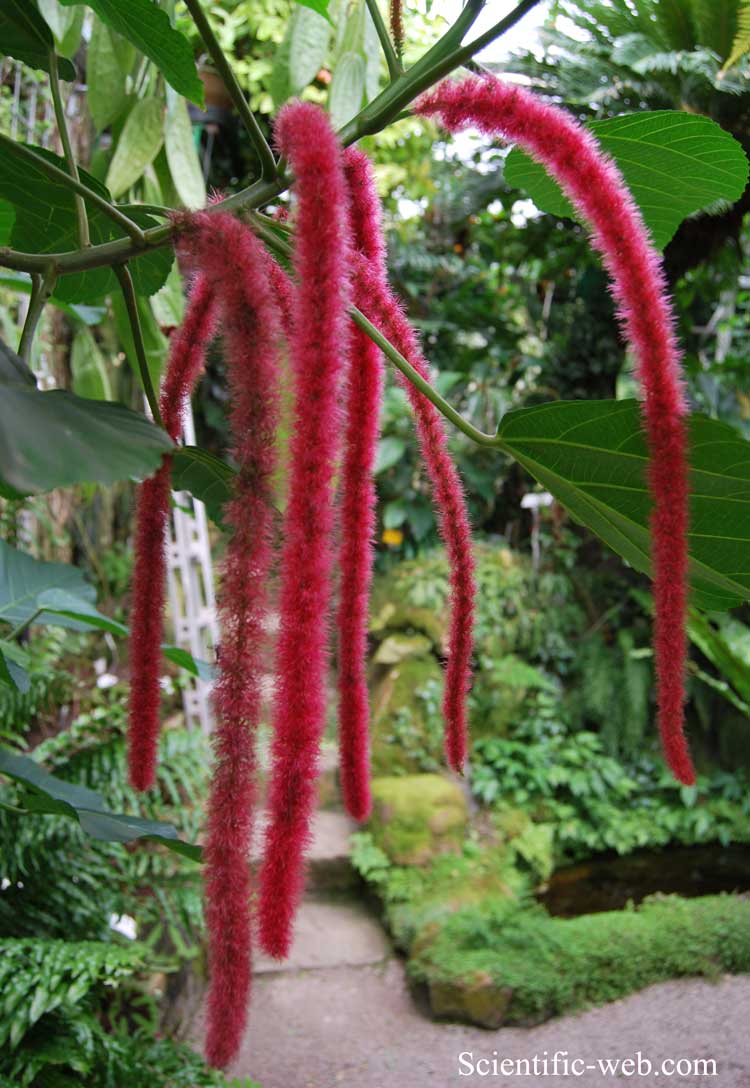
Acalypha hispida, Photo: Michael Lahanas
Classification System: APG IV
Superregnum: Eukaryota
Regnum: Plantae
Cladus: Angiosperms
Cladus: Eudicots
Cladus: Core eudicots
Cladus: Rosids
Cladus: Eurosids I
Ordo: Malpighiales
Familia: Euphorbiaceae
Subfamilia: Acalyphoideae
Tribus: Acalypheae
Genus: Acalypha
Species: Acalypha hispida
Name
Acalypha hispida Burm.f., Fl. Ind. (N. L. Burman) 203, t. 61 (1768)
Synonyms
Homotypic
Acalypha densiflora Blume, Bijdr. Fl. Ned. Ind.: 628 (1826), nom. superfl.
Ricinocarpus hispidus (Burm.f.) Kuntze, Revis. Gen. Pl. 2: 618 (1891).
Heterotypic
Acalypha sanderi N.E.Br., Gard. Chron., ser. 3, 20: 392 (1896).
Acalypha sanderi K.Schum., Notizbl. Bot. Gart. Berlin-Dahlem 2: 127 (1898).
Acalypha hispida var. sanderi (N.E.Br.) J.J.Sm., Meded. Dept. Landb. Ned.-Indië 10: 19 (1910).
Distribution
Native distribution areas:
Continental: Pacific
Bismarck Arch.
References: Brummitt, R.K. 2001. TDWG – World Geographical Scheme for Recording Plant Distributions, 2nd Edition
References
Primary references
Burman, N.L. 1768. Flora Indica: cui accedit series zoophytorum indicorum, nec non prodromus florae capensis. pp. [i–vii], [1]–241 [242 = Elenchus tabularum] [1–17], [1] 1*, 2–28, 25 [bis]–28 [bis], pls 1–21, 21*, 22–67. Lugduni Batavorum [Leiden], Amstelaedami [Amsterdam]: apud Cornelium Haek, apud Johannem Schreuderum. BHL Reference page. : 203,
Links
International Plant Names Index. 2017. Acalypha hispida. Published online. Accessed: Oct. 19 2017.
The Plant List 2013. Acalypha hispida in The Plant List Version 1.1. Published on the internet. Accessed: 2017 Oct. 19.
Tropicos.org 2017. Acalypha hispida. Missouri Botanical Garden. Published on the internet. Accessed: 19 Oct. 2017.
Govaerts, R. et al. 2017. Acalypha hispida in World Checklist of Selected Plant Families. The Board of Trustees of the Royal Botanic Gardens, Kew. Published on the internet. Accessed: 2017 Oct. 19. Reference page.
USDA, ARS, Germplasm Resources Information Network. Acalypha hispida in the Germplasm Resources Information Network (GRIN), U.S. Department of Agriculture Agricultural Research Service. Accessed: 07-Oct-06.
Vernacular names
English: Chenille plant
español: Rabo de gato, Manto de candela, Califa
eesti: Harjaseline nõgesleht
suomi: Isokissanhäntä
français: Queue de chat / Île de la Réunion: queue de minite
magyar: Érdes kutyacsalán
日本語: ベニヒモノキ
Acalypha hispida, the chenille plant, is a flowering shrub which belongs to the family Euphorbiaceae,[1] the subfamily Acalyphinae, and the genus Acalypha. Acalypha is the fourth largest genus of the family Euphorbiaceae, and contains many plants native to Hawaii and Oceania.[2]
Names
Acalypha hispida is also known as Philippine medusa and red hot cat tail in English.[3] It is cultivated as a house plant because of its attractiveness and brilliantly colored, furry flowers.
The Latin specific epithet hispida means “bristly”, referring to the pendent flowers which vaguely resemble brushes.[4]
Origins
The plant originated in tropical Asia, specifically Malesia and Papuasia,[2] but has become naturalized to multiple countries in North America, including the United States, Mexico, Nicaragua and Belize. In cultivation it is widespread, particularly as a houseplant, and has gained the Royal Horticultural Society's Award of Garden Merit.[5]
Description
It can grow to be 5–12 feet (1.5–3.7 m)[1] tall, and have a spread of 3–6 feet (0.91–1.83 m), with potted plants being the smallest in growth.[2] The plant has become somewhat domesticated, due to the nature and color of its flowers. It can be grown from seeds as well as from cuttings. It can be kept either as an outdoor plant or as a houseplant. However, care should be taken in growing it, as all parts of the plant are poisonous if ingested by animals.[6]
The plant is dioecious, and therefore there are distinct male and female members of the species. The female plant bears pistillate flowers which are 0.7 millimeters long and range in color from purple to bright red, and grow in clusters along catkins.[2] This feature is the primary reason the plant bears the nickname “red-hot cat tail”. The pistillates will grow all year long as long as the temperatures are favorable.[2] It is an erect shrub of soft stems cultivated by its precious and tiny flowers of a fiery red which in summer hang on pendulous spikes and resemble the tassels of female plants. The leaves are large, oval and bright green to reddish copper.[7]
Chemistry
The clear latex is poisonous and can irritate the skin and mucous membranes (signs of intoxication do not appear until massive amounts of plants have been absorbed). Roots, leaves and flowers are used for medical purposes. The plant itself is very resistant to diseases, but with a certain vulnerability to aphids, which can colonise it and bring it to death.
References
"Acalypha hispida Chenille Plant". University of Florida. Retrieved 22 September 2011.
"Acalypha hispida". Floridata. Retrieved 22 September 2011.
"Acalypha hispida". Germplasm Resources Information Network (GRIN). Agricultural Research Service (ARS), United States Department of Agriculture (USDA). Retrieved 18 August 2021.
Harrison, Lorraine (2012). RHS Latin for Gardeners. United Kingdom: Mitchell Beazley. ISBN 184533731X.
"Acalypha hispida". Royal Horticultural Society. Retrieved 23 December 2017.
Idárraga-Piedrahita, A., RDC Ortiz, R. Callejas Posada & M. Merello. (eds.) 2011. Fl. Antioquia: Cat. 2: 9-939. University of Antioquia, Medellín.
Correa A., MD, C. Galdames & M. Stapf. 2004. Cat. Pl. Vasc. Panama 1-599. Smithsonian Tropical Research Institute, Panama.
Retrieved from "http://en.wikipedia.org/"
All text is available under the terms of the GNU Free Documentation License

